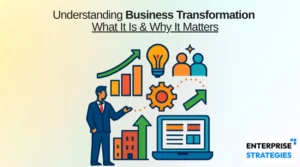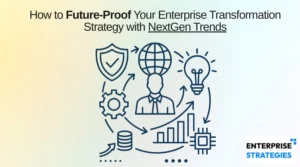Enterprise transformations are pivotal projects that can redefine how a business operates, offering substantial benefits when executed effectively. For company executives, understanding what to expect at different stages of the transformation—beginning, middle, and end—can help in setting realistic goals, monitoring progress, and ensuring long-term success. Here, I outline the key results executives should anticipate during each phase of a well-run enterprise transformation.
Beginning Phase: Setting the Foundation
The initial phase of an enterprise transformation focuses on laying the groundwork for success. During this stage, executives should expect to see:
- Clear Vision and Strategy: The transformation should begin with a well-defined vision and strategy that aligns with the company’s overall business goals. Executives should see a comprehensive roadmap detailing the project’s objectives, key milestones, and expected outcomes.
- Stakeholder Buy-In: Securing buy-in from key stakeholders, including employees, management, and external partners, is crucial. Early indications of strong support and commitment across the organization are vital for sustained momentum.
- Resource Allocation: Proper allocation of resources, including budget, personnel, and technology, should be evident. Executives should expect a detailed plan that outlines how resources will be utilized and managed throughout the transformation.
- Baseline Metrics: Establishing baseline metrics is essential for measuring progress. Executives should see a clear set of initial performance indicators that will be used to track the project’s impact over time.
- Initial Training and Change Management Plans: Comprehensive plans for training and change management should be in place. Executives should expect a detailed strategy for preparing employees to adopt new systems and processes.
Middle Phase: Driving Progress and Managing Change
The middle phase is characterized by the execution of the transformation plan and managing the inevitable changes and challenges that arise. During this stage, executives should look for:
- Incremental Improvements: As the transformation progresses, executives should expect to see incremental improvements in key performance areas. These could include increased efficiency, reduced costs, and enhanced process automation.
- Regular Progress Reports: Frequent updates on the project’s status are essential. Executives should receive regular progress reports that highlight achievements, address any issues, and outline next steps.
- Effective Change Management: Managing change effectively is critical during this phase. Executives should see evidence of successful change management practices, including ongoing training, clear communication, and support for employees adapting to new ways of working.
- Stakeholder Engagement: Continued engagement with stakeholders is vital. Executives should expect to see ongoing efforts to maintain stakeholder involvement and address any concerns or resistance.
- Risk Mitigation: Proactive risk management should be evident. Executives should see a clear plan for identifying and mitigating risks, ensuring that potential obstacles are addressed promptly.
- Interim Results and Adjustments: By this stage, some interim results should be apparent. Executives should expect to see measurable improvements in performance metrics and be prepared to make adjustments based on these outcomes.
End Phase: Realizing the Transformation Benefits
The final phase focuses on consolidating gains and realizing the full benefits of the transformation. Executives should anticipate the following results:
- Achievement of Strategic Goals: By the end of the transformation, executives should see clear evidence that the strategic goals outlined at the beginning have been achieved. This includes enhanced operational efficiency, improved financial performance, and stronger competitive positioning.
- Sustained Performance Improvements: Executives should expect to see sustained improvements in key performance metrics. This includes ongoing cost savings, increased productivity, and better resource utilization.
- Enhanced Employee Capabilities: A successful transformation should result in a more skilled and adaptable workforce. Executives should see evidence of enhanced employee capabilities and greater alignment with the company’s strategic objectives.
- Positive Stakeholder Feedback: Stakeholder feedback is a critical indicator of success. Executives should expect positive feedback from employees, customers, and partners, reflecting the overall success and acceptance of the transformation.
- Scalable and Flexible Systems: The transformation should result in scalable and flexible systems that can support future growth and innovation. Executives should see a robust technological foundation that enables the company to adapt to changing market conditions.
- Return on Investment (ROI): Ultimately, the transformation should deliver a strong ROI. Executives should expect to see a clear financial return that justifies the investment in the transformation, with benefits that extend well into the future.
Conclusion
A well-run enterprise transformation can deliver substantial benefits at each stage of the process. From the clear vision and stakeholder buy-in in the beginning, through incremental improvements and effective change management in the middle, to the realization of strategic goals and sustained performance enhancements at the end, executives should expect to see significant positive outcomes. By understanding these expected results, company leaders can better guide their organizations through the complexities of enterprise transformation, ensuring long-term success and competitive advantage.




